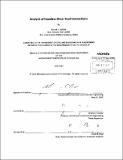Analysis of headless shear stud connections
Author(s)
Spittka, Berndt F. (Berndt Friedrich), 1980-
DownloadFull printable version (12.87Mb)
Other Contributors
United States. Dept. of the Army.
Advisor
Jerome J. Connor.
Terms of use
Metadata
Show full item recordAbstract
Highway bridges are exposed to numerous elemental and loading issues that are extremely difficult for a designer to anticipate and account for during design. The current state of practice is to design a bridge deck for a certain life span and then turn the bridge over to maintenance personnel who attempt to prolong the life of the deck through a variety of repair and rehabilitation measures. These repair measures are rarely, if ever, considered during the design process of the bridge deck. Numerous researchers have looked at making bridges, specifically decks, more repairable. The majority of these research efforts have focused on the bridge deck system as a whole. Other researchers have looked at individual elements of the bridge deck to girder connection to see if the required strength could be achieved while making the connections easier to take apart. One of the main components in the bridge deck to girder system is the steel shear stud connection, which is used to create composite action between the deck and the girder. Numerous researchers have studied this connection from a strength perspective, and the strength equations for the shear connection have been codified. Shear connections using headless studs have been researched as well, but always as a part of a larger deck to girder connection system. The headless stud has never been researched to see how it responds to a shear loading. This study looks at headless studs with varying levels of debonding along the stud shaft to analyze the impact on the load resistance that the levels of debonding would have. Granular materials for the shear transfer of load are also looked at. The results show that, as expected, the headless, debonded shear studs can carry less load than a bonded stud, but the difference in load carrying capacity is within the suggested over-estimation range of the codes that other researchers have suggested. These results suggest that the use of headless, debonded shear studs in a deck to girder connection is a feasible way to make that connection more repairable.
Description
Thesis (S.M.)--Massachusetts Institute of Technology, Dept. of Civil and Environmental Engineering, 2012. Cataloged from PDF version of thesis. Includes bibliographical references (p. 115-117)
Date issued
2012Department
Massachusetts Institute of Technology. Department of Civil and Environmental EngineeringPublisher
Massachusetts Institute of Technology
Keywords
Civil and Environmental Engineering., United States. the Army.